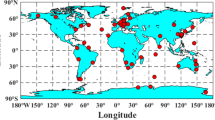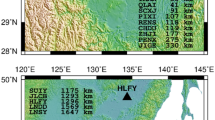Abstract
Considering the applications of deformation monitoring, PPP (precise point positioning) with single-frequency (SF) receivers has the advantages of stand-alone, absolute positioning and cost efficiency. However, the existing SF PPP methods can be hardly implemented for deformation monitoring directly due to their limited precision of submeter level. For this purpose, an innovative approach is presented in this paper with several improvements to the existing approaches: firstly, the SEID (Satellite-specific Epoch-differenced Ionospheric Delay) model is adopted in SF kinematic PPP to handle the ionospheric delays for SF receivers embedded in networks of dual-frequency (DF) receivers; secondly, according to the dynamic characteristic of the monitor station, a combination of kinematic PPP and sliding window based static PPP algorithm is adopted. To confirm the availability of the algorithm for deformation monitoring with SF receiver, a seismic experiment is carried out on an earthquake simulation platform. Comparable positioning precision with 1.5 cm for horizontal and 2.2 cm for vertical is achieved by SF PPP with respect to RTK (real-time kinematic) solution. The new deformation monitoring algorithm with SF receiver can be treated as an effective and low cost way to realize some types of geological hazard monitoring in a wide range.





Similar content being viewed by others
References
Banerjee P, Bürgmann R, Nagarajan B and Apel E 2008 Intraplate deformation of the Indian subcontinent; Geophys. Res. Lett. 35 L18301.
Bevis M, Businger S, Herring T A, Rocken C, Anthes R A and Ware R H 1992 GPS meteorology: Remote sensing of atmospheric water vapor using the Global Positioning System; J. Geophys. Res. 97 (D14) 15,787–15,801.
Blewwit G 1989 Carrier phase ambiguity resolution for the Global Positioning System applied to geodetic baselines up to 2000 km; J. Geophys. Res.: Solid Earth 94 (B8) 10,187–10,203.
Bock Y, Abbot R I, Counselman III C C and King R W 1986 A demonstration of one to two parts in 10−7 accuracy using GPS; Bull. Geodesy 60 241–254.
Bock Y, Nikolaidis R M, de Jonge P J and Bevis M 2000 Instantaneous geodetic positioning at medium distances with the Global Positioning System; J. Geophys. Res. 105 (B12) 28,223–28,253.
Bock Y and Prawirodirdjo L 2004 Detection of arbitrarily large dynamic ground motions with a dense high-rate GPS network; Geophys. Res. Lett. 31 L06604.
Bock Y, Melgar D and Crowell B W 2011 Real-time strong-motion broadband displacements from collocated GPS and accelerometers; Bull. Seismol. Soc. Am. 101 (6) 2904–2925.
Choi K, Bilich A, Larson K M and Axelrad P 2004 Modified sidereal filtering: Implications for high rate GPS positioning; Geophys. Res. Lett. 31 (22) L22608.
Dach R, Hugentobler U, Fridez P and Meindl M 2007 Bernese GPS Software version 5.0; Astronomical Institute, University of Berne.
Deng Z, Bender M, Dick G, Ge M, Wickert J, Ramatschi M and Zou X 2009 Retrieving tropospheric delays from GPS networks densified with single frequency receivers; Geophys. Res. Lett. 36 (19) 1915–1919.
Fang R, Shi C, Song W, Wang G and Liu J 2013 Determination of earthquake magnitude using GPS displacement waveforms from real-time precise point positioning; Geophys. J. Int. 196 461–472.
Ge M, Gendt G, Rothacher M, Shi C and Liu J 2008 Resolution of GPS carrier-phase ambiguities in Precise Point Positioning (PPP) with daily observations; J. Geodesy 82 389–399.
Gendt G, Dick G, Reigber C, Tomassini M and Liu Y 2003 Demonstration of NRT GPS water vapor monitoring for numerical weather prediction in Germany; J. Meteorol. Soc. Japan 82 (1B) 360–370.
Geng J 2010 Rapid integer ambiguity resolution in GPS precise point positioning; Ph.D. Thesis, University of Nottingham.
Hung H and Rau R 2013 Surface waves of the 2011 Tohoku earthquake: Observations of Taiwan’s dense high-rate GPS network; J. Geophys. Res.: Solid Earth 118 (1) 332–345.
Janssen V and Rizos C 2005 Mixed-mode GPS deformation monitoring – A cost effective and accurate alternative; Int. Assoc. Geodesy 128 533–537.
Jin S G, Park P H and Zhu W 2007 Micro-plate tectonics and kinematics in northeast Asia inferred from a dense set of GPS observations; Earth Planet. Sci. Lett. 257 486–496.
Kouba J 2003 Measuring seismic waves induced by large earthquakes with GPS; Stud. Geophys. Geodyn. 47 741–755.
Larson K M, Bodin P and Gomberg J 2003 Using 1-Hz GPS data to measure deformations caused by the Denali fault earthquake; Science 300 (5624) 1421–1424.
Larson K M 2009 GPS seismology; J. Geodesy 83 227– 233.
Mannucci A J, Wilson B D, Yuan D N, Ho C H, Lindqwister U J and Runge T F 1998 A global mapping technique for GPS-derived ionospheric total electron content measurements; Radio Sci. 33 (3) 565–582.
McCarthy D D and Petit G 2004 IERS conventions (2003); IERS Conventions Centre, IERS Technical Note No. 32.
Radovanovic R S 2000 Adjustment of satellite-based ranging observation for precise positioning and deformation monitoring; Ph.D. Thesis, University of Calgary.
Rocken C, Johnson M and Braun J 2000 Improving GPS surveying with modeled ionospheric corrections; Geophys. Res. Lett. 27 3821–3824.
Schaer S 1999 Mapping and predicting the Earth’s ionosphere using the Global Positioning System; Ph.D. Thesis, University of Bern.
Shi C, Lou Y, Zhang H, Zhao Q, Geng J, Wang R, Fang R and Liu J 2010 Seismic deformation of the M w 8.0 Wenchuan earthquake from high-rate GPS observations; Adv. Space Res. 46 (2) 228–235.
Shi C, Gu S, Lou Y and Ge M 2011 An improved approach for modeling ionospheric delays for single-frequency precise point positioning; Adv. Space Res. 49 (12) 1698–1708.
Tétreault P, Kouba J, Héroux P and Legree P 2005 CSRS-PPP: An internet service for GPS user access to the Canadian spatial reference frame; Geomatica 59 (1) 17–28. http://www.novatel.com/products/waypoint-software/waypoint-post-processing-software/grafnav-grafnet/ http://www.novatel.com/products/waypoint-software/waypoint-post-processing-software/grafnav-grafnet/.
Wang J, Satirapod C and Rizos C 2002 Stochastic assessment of GPS carrier phase measurements for precise static relative positioning; J. Geodesy 76 (2) 95–104.
Wang X, Tao B, Qiu W and Yao Y 2006 Advanced Surveying Adjustment; Wuhan, China, Surveying and Mapping Press, 17p.
Yao Y and Zhang R 2012 PPP new algorithm based on sliding window and its application in earthquake coseismic deformation monitoring; Geomatics and Information Science of Wuhan University (submitted) (in Chinese).
Zou X, Deng Z, Ge M, Dick G, Jiang W and Liu J 2010 GPS data processing of networks with mixed single- and dual-frequency receivers for deformation monitoring; Adv. Space Res. 46 (2) 130–135.
Zumberge J F, Heftin M B, Jefferson D C, Watkins M M and Webb F H 1997 Precise point positioning for the efficient and robust analysis of GPS data from large networks; J. Geophys. Res. 102 5005–5017.
Acknowledgement
This study is supported by the Fundamental Research Funds for the Central Universities (2652014065).
Author information
Authors and Affiliations
Corresponding author
Rights and permissions
About this article
Cite this article
Zheng, Y., Zhang, R. & Gu, S. A new PPP algorithm for deformation monitoring with single-frequency receiver. J Earth Syst Sci 123, 1919–1926 (2014). https://doi.org/10.1007/s12040-014-0502-4
Received:
Revised:
Accepted:
Published:
Issue Date:
DOI: https://doi.org/10.1007/s12040-014-0502-4




